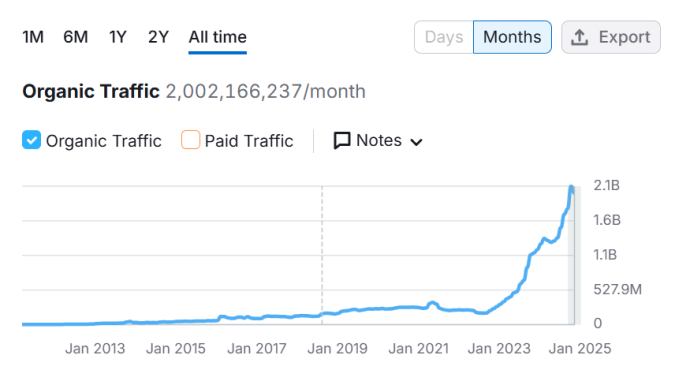Guest posting isn’t what it used to be, it’s harder than ever to get a guest post accepted.
What’s holding your guest posting program back?
We’ll look at the 7 things most people do when guest posting that are actually working against them. Avoid them in order to get your guest post published.
What Most People Do With Guest Posting That You Shouldn’t
1. Shop around already completed pieces
You’ve written an epic piece. You want to find a home for it, ideally on a blog you admire. So you decide to reach out to a few different editors with a pitch that exactly matches your epic piece. With fingers crossed, you wait for what you hope is a quick acceptance.
Your plan? To hand the editor a finished piece about 2 seconds after they accept your pitch.
The bad news is, most blogs don’t want your already-written piece. They go so far as to reject these pieces outright or put in the guidelines that they aren’t accepted. Blogs want a post curated specifically for their blog. Not something you wrote without them in mind—and need to find a home for ASAP.
What to do instead
Instead of writing posts and shopping them around, put your energy into researching blogs you enjoy. Even better if they’re blogs you love to read and that share a similar audience to yours.
Read 3-5 of their posts, plus their about page. Brainstorm ideas that you think their audience would find useful. Run a search to make sure the topic hasn’t already been written about on the blog. Then, pitch post ideas you’ve come up with. Even better if you’ve got a list of potential headers to help shape the scope of the potential piece.
Blog editors and owners are a lot more likely to sign off on topics when they can tell you’ve done your research and want to provide them with a helpful piece.
2. Use a pitch template
Pitch templates sound good in theory. With just one document, you can make tweaks here and there to create pitches for all sorts of different blogs—without spending hours doing it. Plenty of would-be guest posters do this. If you do it now or have done it in the past, we get it.
But using pitch templates is a mistake. As good as they are for saving time, people rely on pitch templates too much. They change the name and a couple of sentences and send them off, one after another, like a machine.
Pitches become stale, editors hate them, and rejections become the norm.
Plus, it’s way too easy to mess up on one of these copy-paste templates. What if you accidentally leave the name of Blog A on a pitch sent to Blog B? It’s an instant rejection and a big turnoff for Blog B.
Another downside? Pitch templates leave little room for customization. When it comes to pitching, customization is everything. Blog owners and editors want to know that you’re thinking specifically of them when you’re crafting a pitch.
But we totally understand that this takes time. A lot of it.
There’s a solution, though, and it’s easier than you think.
What to do instead
Instead of using a standard pitch template for everyone on your dream guest posting list, use a light framework you can customize for each pitch. Instead of primarily being a time-saving machine, this framework makes sure you include all the important parts of a pitch:
- Hooks to start the piece
- How you break down the post idea
- Potential headers and keywords
- What they should read of yours for sample work
- Concluding sentences
It might look something like this:
_____
[Salutation—aka “Hi, {name of blog owner or editor}”],
[Quick intro on who you are, what you like about their blog, and what you’d like to guest post about.]
[Hooks you will use to start the piece + keywords you would use]
[A quick, bullet-points overview of how you’d break down the post idea]
[2-3 links to relevant samples of your blog posts/other guest posts]
[Concluding sentences]
[Complimentary close, including your email, phone number, and credentials]
[A check box for the pitching rules to follow as per the blog’s guidelines—delete once you’ve nailed every requirement.]
_____
As you pitch and land spots as a guest poster on other blogs, make note of what seems to work for pitches—and what doesn’t. Save snippets that you can re-work for future pieces.
But overall, strive to create original pitches each and every time.
3. Pitch primarily big blogs
It’s a dream to be featured in big publications and blogs with millions of monthly visitors. The idea of these big-name audiences potentially heading over to your little ol’ blog can be heady stuff.
Even more thrilling, many of these bigger blogs solicit guest posts—and pay cold hard cash, too.
It’s no surprise that most people spend a ton of time pitching big blogs.
But solely focusing on the bigger names is a mistake. It’s really, really difficult to get noticed and featured in big blogs.
Before you glare at us for stomping on your dreams, we’re not suggesting you should never pitch big blogs. Just that you shouldn’t pitch ONLY big blogs.
What to do instead
Pitch the small blogs too!
Look for these qualities before doing your pre-pitch research:
- They’re within your niche or industry
- Their audience matches yours
- The blog is active
- The comments section is alive and well—ie, they have an engaged following
The simple truth of it is this: you’re more likely to get noticed and published with these blogs. As far as pitching efforts go, we recommend sending 70% of pitches to small and midsized blogs and 30% to the big guns.
4. Leave promotion to the site
Picture this: a guest post gets published on a blog. The writer posts about it on their social media accounts on publish day, and maybe a few days later. After that, they kind of forget about promotion. They leave it up to the blog editor or owner to spread the word.
This all-too-common scenario is a mistake for two reasons:
- Blog editors/owners are busy. Your post is one of the many other posts they need to promote. They will probably do their best to promote the post, but they’re not going to be able to give it the care and attention you can.
- Short-lived promo means missing out on a lot of reach and exposure. When the blog is doing most of the promoting, you’re missing out on lots of potential readers. Why? Because, again, you have more time and attention to give your guest post than they do.
Here’s the fix.
What to do instead
Promote your guest posts yourself. Go way beyond social media posts on publication day. Instead, do this:
- Talk about upcoming posts 1 week before they go live. This builds anticipation on your social media and digital marketing channels.
- Take advantage of pub day. On publication day, post about your guest post 3 times on all your digital marketing channels—morning, noon, and night. Highlight what readers will find useful or interesting about the piece. Experiment with different hooks and see which ones attract the most clicks.
- Pin the post to the top of all your social media feeds/profiles. This keeps it top-of-mind for anyone who visits your page.
- Keep highlighting the post for a few weeks after it goes live. At least twice a week, highlight your post. Come at it from a different angle, using different keywords or hashtags than you did on pub day. Because of the fickle nature of algorithms, some readers may not even have seen it the first time.
- Ask if you can collaborate with the blog to promote the post. Social media takeovers, live Q&As, and podcast appearances are all great ideas for collaborative promotion. Chances are, the blog owner/editor will be thrilled that you want to team up. This type of promotion benefits both of you!
5. Neglect comments on guest posts
So many guest posters get their piece published and never visit the site again. Meanwhile, comments are piling up, people are asking for more, and the blogger is missing out on a chance to grow their traffic and following.
Don’t let yourself fall into this set-it-and-forget-it trap.
Comments on a blog post mean people are connecting to the content you’ve written. When you engage with comments, you’re strengthening that connection.
That’s why you wrote the guest post, isn’t it?
You’ve got to take advantage of it.
What to do instead
Ask the blog owner if there’s any way you can get a notification when people comment on your guest post. If not, that’s OK. You can just set a reminder to visit the comments section every day in the week after the post goes live. If you see comments, respond to them—and make sure you identify yourself as the guest blogger.
When the comments start to slow down, you can slow your visits to a couple times a week. Eventually, you may only visit once or twice a month. But it’s always a good idea to visit the post indefinitely. Because you’ve got one goal here: to answer every single comment.
This makes your audience feel valued and heard, and they just might head over to your site to get more of what you’re offering.
6. Prioritize quantity over quality when it comes to pitches
Honestly, guest posting is a numbers game. The more pitches you put out, the better chance you have of getting pitches accepted.
It’s no wonder why most people prioritize sending out as many pitches as possible.
But more often than not, people start neglecting the quality of the pitch for the sake of getting as many pitches out as possible. Then they start relying heavily on templates, ignoring personalization and creativity.
This leads to fewer accepted pitches—and would-be guest bloggers either ratchet up their pitching machine or give up.
You don’t have to do either of those things.
What to do instead
The best thing you can do is learn to create quality pitches quickly. This takes practice. It takes following a high-quality framework, like the one we outlined earlier, and figuring out the most efficient way to learn what you need to learn to fill in the framework with an outstanding pitch.
Eventually, you’ll get faster at pitching. But quality should always, always come first. Figure out how many quality pitches you can comfortably send out each week or month—and do that.
Whatever you do, don’t sacrifice quality for the sake of sending out mass numbers of pitches.
7. Don’t get noticed by the blog owner first
Most people pitch blogs cold, which means they don’t know the blog or owner before they pitch. So, they have to create a truly stellar, unique pitch just for the chance of being noticed. Because spoiler alert: most people delete cold pitches before reading them. Almost no one likes receiving cold pitches.
Instead of relying on this method, focus on building a relationship with the blog owner or editor prior to pitching.
Here’s how.
What to do instead
Find out who the blog owner is. Look them up on LinkedIn, Threads, or Instagram. Take a couple of weeks to comment on their social media posts and the blog posts they publish during this time.
Don’t spam their posts or offer up fluff comments, though.
Read their posts. Like, really read them. Respond with a thoughtful and valuable comment. You could share why their post is meaningful to you—how it relates to something similar in your own life. Or, let them know why what they’ve written is helpful or inspiring.
The blog owner will begin to recognize you as someone who contributes to their social media community. When you pitch a guest post, they’ll already know who you are—and they’ll be more inclined to read your pitch.
A Recap: Everything You SHOULD Do With Guest Posting to Thrive
As you head off to your laptop to type up a guest post pitch, keep these tips in mind:
- Only pitch post ideas you’ve come up with in real time—not posts you’ve already written.
- Use a flexible framework to remember to nail all the must-have info in a pitch, including hooks to start the post, how you’ll break down the post idea, what they can read for sample work, and so forth. No cut-and-paste templates allowed.
- Pitch small blogs within your niche or industry just as much or more than big blogs. Use the 70/30 rule: send 70% of pitches to small and mid-sized blogs and 30% to your dream blogs.
- Promote your guest posts yourself, both before and well after publication.
- Answer every comment on your guest posts.
- Learn to create quality pitches quickly.
- Build a connection with the blog owner before you pitch.
With these tips in hand, you’ll land spots on guest blogs in no time. You’ll also become recognized as a guest blogger who goes out of their way to create a meaningful experience for everyone involved.






